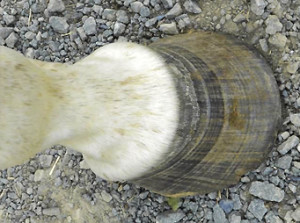The Inside Scoop on Hoof & Joint Supplements
Click here to read the complete article180 – August/September, 2017
By Heather Smith Thomas
 Horses need proper nutrition for health, and this includes hoof and joint health. There are many supplements on the market to aid horse owners in providing an adequate and balanced diet for their horses with the goal of improving hoof strength/growth and protecting the joints from wear-and-tear problems. Scott Gravlee, DVM, CNS, Equine Nutrition Consultant, Life Data Labs, Inc. strives to help educate farriers and horse owners about the importance of nutrition for hoof health— with telephone consults, educational materials, and seminars. “The better the hoof, the more the farrier has to work with, and it’s easier to do a better job of caring for the feet and keeping the horse sound,” he says.
Horses need proper nutrition for health, and this includes hoof and joint health. There are many supplements on the market to aid horse owners in providing an adequate and balanced diet for their horses with the goal of improving hoof strength/growth and protecting the joints from wear-and-tear problems. Scott Gravlee, DVM, CNS, Equine Nutrition Consultant, Life Data Labs, Inc. strives to help educate farriers and horse owners about the importance of nutrition for hoof health— with telephone consults, educational materials, and seminars. “The better the hoof, the more the farrier has to work with, and it’s easier to do a better job of caring for the feet and keeping the horse sound,” he says.
There are nutritional factors that can affect hoof health, and some of the problems are caused by too much of a certain feed or nutrient. A balanced diet is the first step, before a person starts thinking about supplements, so the horse isn’t getting an excess of certain nutrients.
“For instance, excessive bran in the diet can lead to poor hoof quality,” he says. Bran has been traditionally fed as a source of fiber, and a bran mash was a common winter feed with the thought of helping keep the horse warm. Horses like to eat bran, but too much of it can create a serious imbalance in the diet.
“Bran is high in a compound called phytate, which is high in phosphorus. Excess phosphorus interferes with the absorption and utilization of calcium and this leads to poor hoof horn. It can also cause miller’s disease in horses, often called ‘big head’. The by-product of milling flour is bran—the hulls from the wheat. Many years ago grain millers had all that bran that they didn’t know what to do with except feed it to horses. Bran is a good energy food; the fiber is converted to volatile fatty acids, which can be a source of energy. The millers fed the bran by-product to the horses that turned the big stones for milling the grain,” he says.
With the excess phosphorus tying up calcium, the body would draw calcium from the bones. “The bones of the head are thin, especially along the fissure between the two main skull bones, and the horse would develop a big head. The medical term for this is nutritional secondary hyperparathyroidism. These horses with big heads had poor feet, as well,” says Gravlee.
“Calcium is required for the strength of connective tissue in the hoof wall, and calcium deficiency leads to hoof horn that’s not welded together very well,” he says.
“Another problem we see sometimes is excessive sulfur in the diet. The sulfur interferes with absorption of copper—and copper is important for proper development of connective tissue. One thing that often causes excessive sulfur in diet is a combination of hoof supplements and joint supplements. Most joint supplements include a compound called MSM which is a chemical form of sulfur. MSM is about 34% sulfur. Sulfur is important for connective tissue, but too much can be detrimental,” he explains.
Click here to read the complete article180 – August/September, 2017










